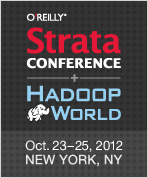Here are few stories from the data space that caught my attention this week.
Data mining Kickstarter
ThingsWeStart, an interactive visualization map designed to aid in Kickstarter project discovery, launched this week. The map tracks Kickstarter projects in real time and mines Kickstarter data to allow users to drill down to very specific project search results using filter combinations, something you can’t do within Kickstarter itself. For instance, here’s a screenshot of all the projects in San Francisco:
Notice on the right, there’s a list of the top 25 projects in the designated area, buttons to sort by funding amounts reached, and a field to request an email notification about new projects that come to the specified area. Here’s that same map, drilled down into three project categories:
The geography can be isolated in an area down to the zip code, so you can isolate projects in Brooklyn as opposed to New York City, for instance. (Click here for the live map.)
You can download the ThingsWeStart data spreadsheet (as of the launch) here, and you can read more about the project and its founders on the project blog, at Mashable and at Wired.
 Strata Conference + Hadoop World — The O’Reilly Strata Conference, being held Oct. 23-25 in New York City, explores the changes brought to technology and business by big data, data science, and pervasive computing. This year, Strata has joined forces with Hadoop World.
Strata Conference + Hadoop World — The O’Reilly Strata Conference, being held Oct. 23-25 in New York City, explores the changes brought to technology and business by big data, data science, and pervasive computing. This year, Strata has joined forces with Hadoop World.
UDID breach traced to BlueToad, Inc., not FBI
The source of the Apple UDID records hacker group AntiSec released earlier this month has been identified by security consultant David Schuetz. Schuetz traced the source back not to a stolen FBI laptop as initial claims by the hackers indicated, but to app development company BlueToad, Inc. In a post detailing his search methods and a chronology of his findings, Schuetz writes:
“I had decided to look more closely at the most frequently repeated device IDs, on the theory that perhaps that would belong to a developer.”
This ultimately led to the discovery of device names pointing to the source, including ‘Bluetoad Support’, ‘Customer Service iPad’, ‘Developer iPad’, ‘Hutch Hicken’s iPad’, and ‘CSR/Marketing iPad’. Schuetz writes:
“By the time I went to bed, I had identified nineteen different devices, each tied to BlueToad in some way. One, appearing four times, is twice named ‘Hutch’ (their CIO), and twice named ‘Paul’s gift to Brad’ (Paul being the first name of the CEO, and Brad being their Chief Creative Officer). I found iPhones and iPads belonging to their CEO, CIO, CCO, a customer service rep, the Director of Digital Services, the lead System Admin, and a Senior Developer.”
BlueToad CIO Hutch Hicken got wind of Schuetz’s investigation, uncovered his own evidence that corroborated his company’s inadvertent involvement and came forward. Schuetz and BlueToad CEO Paul DeHart were subsequently interviewed for an NBC report — you can watch the video here.
Technology consultant and University of Exeter senior research fellow Alasdair Allan also engaged in a hunt for the source of the breach. He wrote a detailed post on his search process on O’Reilly’s Radar website, and ultimately found Schultz’s findings to support his own analysis. Allan writes:
“BlueToad makes apps for magazine publishers, hence the predominance of of the iPad over the iPhone in my results, as those apps are more often used on the iPad. Also they seem to mostly market into the U.S., which supports my ethnicity findings, and looking at the list of titles they curate, it does look like my demographics are more-or-less spot on as well. Those look like magazines marketed to men in their 30s and 40s to me. I’d actually been really confused about what type of app could possibly have that narrow a demographic, and this sort of clears up my confusion.”
You can read Allan’s account of his search here, and Schuetz also has a detailed analysis of the initial situation here.
Measuring big data one person at a time
Derrick Harris at GigaOm took a look this week at photographer Rick Smolan’s global crowdsourcing project The Human Face of Big Data. The project will culminate in a book of images, also titled The Human Face of Big Data, but the really interesting piece will begin September 25 as Smolan begins a week-long gathering of data from people around the world, one smartphone at a time. Harris describes this stage of the project:
“… the project begins on Sept. 25, when citizens around the world can download a smartphone app that’s all about data collection. It gathers the passive data that phones generate (e.g., number of emails sent, location data, number of steps, noise levels, etc.) and also asks users specific questions about themselves and their lifestyles. The data is all anonymized, aggregated and easily sortable, and Smolan says the hope is that users will play around with it to learn about the people around them.”
The project will continue, Harris reports, on October 2 in a worldwide data presentation, where attendees in London, New York and Singapore will get a thorough introduction to big data and the role it’s playing in the world in hopes that big data awareness will spread. The book will be released November 20, 2012. You can learn more about the project from Smolan himself in the following video:
Tip us off
News tips and suggestions are always welcome, so please send them along.
Related:


